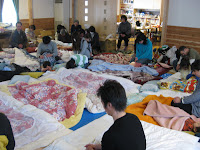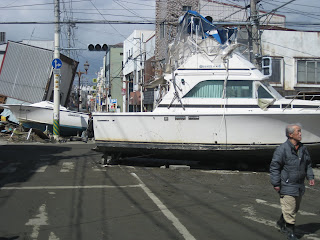
Pastor Sato leads one of the biggest churches in Japan with over 200 people. During the earthquake he was attending the graduation of his son-in-law from seminary at Tokyo Christian Institute (TCI) in Chiba. His church is north of Iwaki, in an area devastated first by earthquake, then tsunami (which wiped out the train station and half the town), and THEN the radiation from the nu

clear reactors! No one is allowed to return to that area for months. The evacuation was so quick that people had nothing but the clothes on their back. He was desperately worried and arranged for an emergency shelter in a church in Western Fukushima to try to account for everybody.
Seima Aoyagi (assistant pastor Grace City Church Tokyo), Matt Chase (Mission to the World missionary), and I headed out with a truck full of supplies to TCI to meet up with the pastor and start heading toward Aizuwakamatsu. We didn't know if we had enough diesel fuel to make it that far and definitely didn'

t have enough to get back. Nevertheless, we left having faith that God would provide what we needed along the way.
It took 14 hours to reach the temporary emergency shelter using back roads the whole way, then we found ab

out 25 of the evacuees. Another 25 or so were at the hospital being checked for radiation poisoning. The other 150 church members were still unaccounted for! The first thing that happened when we arrived was not unloading the truck but a worship service. People need worship!
The pastor gathered the people and started to sing a hymn "What A Fr

iend We Have In Jesus." Everybody joined in. He then began speaking from scripture. "The last time we had worship together, I spoke from Habakkuk. God's word, God's promises, and God's love for us are just as real now as they were before the earthquake. It is written 'Though the fig tree does not bud and there are no grapes on the vines, though the olive crop fails and the fields produce no food, though there are no sheep in the pen and no cattle in the stalls, yet I will rejoice in the Lord, I will be joyful in God my Savior. The Sovereign Lord is

my strength; he makes my feet like the feet of a deer, he enables me to go on the heights.'" The pastor then went on to show that God does watch over us and cares for us. There were MANY tears.
After worship, we unloaded the truck, had lunch, then most of the men headed out to bring gas to stranded cars and check on the people at the hospital. I noticed a keyboard in the corner, mentioned to the pastor's wife that I was a musician, and asked if she would like a concert. Immediately she gathered the people. I started "It's hard to have words in situations like this, but that is why God gave us music." After playing a number of pieces, I played a gospel arrangement of "Amazing Grace" and gave a short testimony. It was a pretty powerful time, and they didn't want me to stop. Maybe I should be traveling around to the emergency shelters with not just food but music? Thinking about how to care for people emotionally and spiritually from here on out...



















































